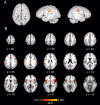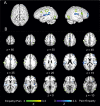Shared and distinct functional networks for empathy and pain processing: a systematic review and meta-analysis of fMRI studies
- PMID: 32608498
- PMCID: PMC7511882
- DOI: 10.1093/scan/nsaa090
Shared and distinct functional networks for empathy and pain processing: a systematic review and meta-analysis of fMRI studies
Abstract
Background: Empathy for pain is a complex phenomenon incorporating sensory, cognitive and affective processes. Functional neuroimaging studies indicate a rich network of brain activations for empathic processing. However, previous research focused on core activations in bilateral anterior insula (AI) and anterior cingulate/anterior midcingulate cortex (ACC/aMCC) which are also typically present during nociceptive (pain) processing. Theoretical understanding of empathy would benefit from empirical investigation of shared and contrasting brain activations for empathic and nociceptive processing.
Method: Thirty-nine empathy for observed pain studies (1112 participants; 527 foci) were selected by systematic review. Coordinate based meta-analysis (activation likelihood estimation) was performed and novel contrast analyses compared neurobiological processing of empathy with a comprehensive meta-analysis of 180 studies of nociceptive processing (Tanasescu et al., 2016).
Results: Conjunction analysis indicated overlapping activations for empathy and nociception in AI, aMCC, somatosensory and inferior frontal regions. Contrast analysis revealed increased likelihood of activation for empathy, relative to nociception, in bilateral supramarginal, inferior frontal and occipitotemporal regions. Nociception preferentially activated bilateral posterior insula, somatosensory cortex and aMCC.
Conclusion: Our findings support the likelihood of shared and distinct neural networks for empathic, relative to nociceptive, processing. This offers succinct empirical support for recent tiered or modular theoretical accounts of empathy.
Keywords: activation likelihood estimation; neuroimaging; perception action model.
© The Author(s) 2020. Published by Oxford University Press.
Figures




Similar articles
-
Regional and whole-brain neurofunctional alterations during pain empathic processing of physical but not affective pain in migraine patients.J Headache Pain. 2025 Jun 12;26(1):137. doi: 10.1186/s10194-025-02051-x. J Headache Pain. 2025. PMID: 40506706 Free PMC article.
-
Neural mechanisms of physical and social pain empathy: an activation likelihood estimation meta-analysis of fMRI studies.Cereb Cortex. 2025 Aug 1;35(8):bhaf227. doi: 10.1093/cercor/bhaf227. Cereb Cortex. 2025. PMID: 40833263
-
Social hierarchy modulates neural responses of empathy for pain.Soc Cogn Affect Neurosci. 2016 Mar;11(3):485-95. doi: 10.1093/scan/nsv135. Epub 2015 Oct 29. Soc Cogn Affect Neurosci. 2016. PMID: 26516169 Free PMC article.
-
Meta-analytic evidence for common and distinct neural networks associated with directly experienced pain and empathy for pain.Neuroimage. 2011 Feb 1;54(3):2492-502. doi: 10.1016/j.neuroimage.2010.10.014. Epub 2010 Oct 12. Neuroimage. 2011. PMID: 20946964 Review.
-
A meta-analysis of neuroimaging studies on pain empathy: investigating the role of visual information and observers' perspective.Soc Cogn Affect Neurosci. 2019 Aug 31;14(8):789-813. doi: 10.1093/scan/nsz055. Soc Cogn Affect Neurosci. 2019. PMID: 31393982 Free PMC article.
Cited by
-
Volitional Modulation of the Left DLPFC Neural Activity Based on a Pain Empathy Paradigm-A Potential Novel Therapeutic Target for Pain.Front Neurol. 2020 Jul 21;11:714. doi: 10.3389/fneur.2020.00714. eCollection 2020. Front Neurol. 2020. PMID: 32793103 Free PMC article.
-
Unveiling the Truth in Pain: Neural and Behavioral Distinctions Between Genuine and Deceptive Pain.Brain Sci. 2025 Feb 12;15(2):185. doi: 10.3390/brainsci15020185. Brain Sci. 2025. PMID: 40002518 Free PMC article.
-
A feature-based network analysis and fMRI meta-analysis reveal three distinct types of prosocial decisions.Soc Cogn Affect Neurosci. 2021 Dec 30;16(12):1214-1233. doi: 10.1093/scan/nsab079. Soc Cogn Affect Neurosci. 2021. PMID: 34160604 Free PMC article.
-
Neural defensive circuits underlie helping under threat in humans.Elife. 2022 Oct 25;11:e78162. doi: 10.7554/eLife.78162. Elife. 2022. PMID: 36281636 Free PMC article.
-
Regional and whole-brain neurofunctional alterations during pain empathic processing of physical but not affective pain in migraine patients.J Headache Pain. 2025 Jun 12;26(1):137. doi: 10.1186/s10194-025-02051-x. J Headache Pain. 2025. PMID: 40506706 Free PMC article.
References
-
- Akitsuki Y., Decety J. (2009). Social context and perceived agency affects empathy for pain: an event-related fMRI investigation. NeuroImage, 47(2), 722–34. - PubMed
-
- Azevedo R.T., Macaluso E., Viola V., Sani G., Aglioti S.M. (2014). Weighing the stigma of weight: an fMRI study of neural reactivity to the pain of obese individuals. NeuroImage, 91, 109–19. - PubMed
Publication types
MeSH terms
LinkOut - more resources
Full Text Sources
Medical

